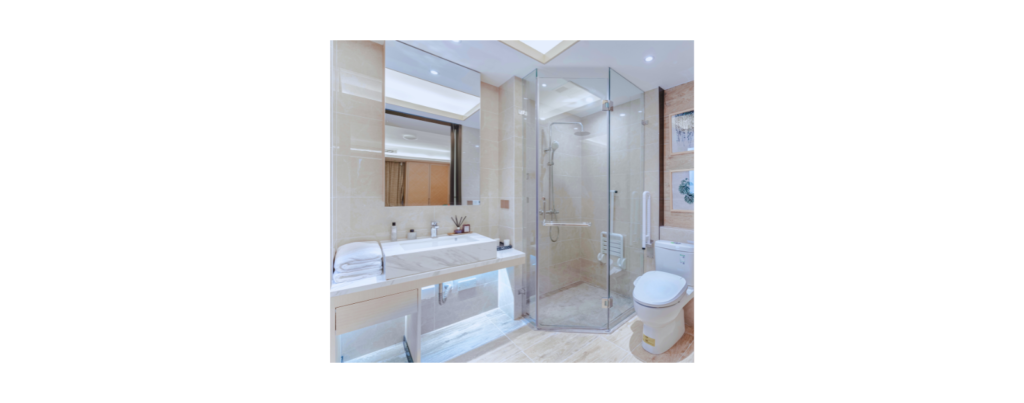Cleaning the bathroom might not be your favorite chore, but with the right tools and a plan, it’s a breeze. I’ll walk you through my tried-and-true steps to get your bathroom sparkling in no time. Grab your gloves and let’s get started!
Step 1: Gather Your Supplies
Before diving in, make sure you have everything you need:
- Toilet brush
- Baking soda
- Toilet cleaner
- Glass cleaner
- Dish soap
- Distilled white vinegar
- Disinfectant spray
- Microfiber cloths
- Scrub brush and pads
- Spray bottle
- Trash bag
- Paper towels
- Grout brush
- Damp cloth
Having everything on hand saves time and keeps you focused. If possible, keep these supplies in a dedicated cleaning caddy to make your bathroom cleaning routine even more efficient.
Step 2: Declutter and Prep
- Remove dirty laundry: Toss any wet towels and dirty clothes into the hamper. This clears the floor and prevents mildew.
- Clear surfaces: Take everything off counters, shelves, and the shower area. Store items in a plastic bin temporarily to keep them organized.
- Ventilate the room: Open a window or turn on the fan to reduce humidity and let fresh air in. This prevents the growth of mold and mildew.
Step 3: Dust and Vacuum
Dusting and vacuuming are essential steps in cleaning your bathroom. Start by dusting all surfaces, including light fixtures, ceiling fans, and decorative items. Use a microfiber cloth to dust surfaces, as it will help to trap dust particles and prevent them from spreading to other areas.
Next, vacuum the bathroom floor, paying attention to corners, crevices, and areas around the toilet and shower. Use a vacuum cleaner with a gentle suction setting to avoid scratching the floor. If you have a tile or hardwood floor, use a vacuum cleaner with a soft-bristled brush attachment to gently sweep away dust and debris.
Step 3: Clean the Toilet with a Toilet Brush
- Apply toilet cleaner to the bowl, ensuring it covers the entire interior. Let it sit for at least 10 minutes to break down grime.
- Use a scrub brush to clean the inside of the bowl, focusing on tough stains and under the rim.
- Wipe down the toilet seat, hinges, and exterior with a disinfecting wipe or a vinegar solution. Don’t forget to clean the base where dust tends to accumulate.
Step 4: Tackle Soap Scum and Shower Areas
- Shower curtains: Toss fabric ones into the washing machine with warm water and mild detergent. Wipe down plastic liners with soapy water and rinse well.
- Shower head: Soak in a plastic bag filled with white vinegar tied around the head. Leave it for 20 minutes, then scrub with a small brush and rinse thoroughly.
- Shower walls and doors: Spray with a mixture of dish soap and vinegar. Scrub with a microfiber cloth or scrub pads to remove buildup. Rinse with warm water and dry with a lint-free cloth to prevent water spots.
Step 6: Clean Glass and Mirrors
Cleaning glass and mirrors is a crucial step in making your bathroom sparkle. Use a glass cleaner and a lint-free cloth or paper towel to wipe down mirrors, glass shower doors, and any other glass surfaces. Spray the glass cleaner onto the cloth, not directly onto the surface, to avoid streaks and residue.
For particularly stubborn streaks or water spots, use a microfiber cloth and a small amount of dish soap. Gently scrub the area, then rinse with warm water and dry with a clean microfiber cloth.
Step 5: Surfaces and Fixtures with a Microfiber Cloth
- Countertops and sinks: Wipe with a mix of baking soda and warm water. For stubborn spots, use a scrub brush. Pay extra attention to areas around the faucet where grime builds up.
- Faucet handles: Polish with a damp cloth and vinegar solution, ensuring you remove all fingerprints and water stains.
- Light fixtures: Dust with a lint-free material and wipe with a damp cloth. If fixtures are removable, wash them with soapy water and dry before reinstalling.
- Mirror and glass: Clean with a glass cleaner for streak-free shine. Use a microfiber cloth to ensure a polished finish.
Step 8: Disinfect High-Touch Areas
Disinfecting high-touch areas is essential to prevent the spread of germs and bacteria in your bathroom. Use a disinfectant spray and a microfiber cloth to wipe down areas such as the toilet seat, toilet handle, sink faucets, and doorknobs.
Pay particular attention to the toilet seat and handle, as these areas are prone to harboring bacteria and germs. Use a toilet brush to scrub the inside of the toilet bowl, then disinfect the seat and handle with a disinfectant spray.
Step 6: Floors and Finishing Touches
- Dust first: Use a damp cloth to knock dirt from door frames, baseboards, and window sills. This prevents dust from falling onto your freshly cleaned floors.
- Mop floors: Use hot water and your preferred cleaner for ceramic tile or grout. Scrub with a grout brush if needed, especially in areas prone to discoloration. For bathroom floors, adopt a multilevel cleaning approach to ensure thorough cleanliness. These surfaces often accumulate dust, hair, and grime, particularly in corners, making it essential to clean them meticulously.
- Empty trash: Replace the bag in the trash can and spray the exterior with disinfectant to keep it fresh and clean.
- Add a final touch: Place clean towels, refill soap dispensers, and restock toilet paper. Consider adding a small plant or scented candle for a welcoming vibe.
Step 10: Take a Final Walk-Through
Once you’ve completed all the steps in cleaning your bathroom, take a final walk-through to ensure everything is sparkling clean and in its place. Check for any streaks or water spots on mirrors and glass surfaces, and wipe down any areas that may have been missed.
Take a moment to admire your hard work and enjoy the feeling of a clean and hygienic bathroom. Remember to deep clean your bathroom regularly to maintain its cleanliness and prevent the buildup of soap scum, mildew, and bacteria.
Extra Tips for a Sparkling Bathroom
- Seal grout lines: Use a grout sealer every six months to prevent stains and buildup.
- Wipe condensation: After every shower, use a squeegee or clean cloth to wipe down glass shower doors and tiles. This reduces water spots and mold growth.
- Disinfect door knobs: Don’t overlook door knobs, light switches, and other frequently touched surfaces.
- Freshen the air: Place a bowl of baking soda or a sachet of activated charcoal in the room to absorb odors.
- Deep cleaning: Focus on deep cleaning your bathroom to eliminate germs and stains. Start by removing all items from surfaces, then scrub tiles, grout, and fixtures with a suitable cleaner. Pay special attention to hidden areas like behind the toilet and under the sink. Finish by mopping the floor with a disinfectant solution.
- Deeper clean: On a monthly or quarterly basis, give specific areas a deeper clean to prevent buildup and ensure a sanitary environment. This includes tasks like descaling showerheads, cleaning exhaust fans, and washing shower curtains or liners.
FAQs
Q: How often should I clean my bathroom?
A: A quick clean once a week and a deep clean every month works well for most households.
Q: Can I use vinegar on all surfaces?
A: Avoid vinegar on natural stone like granite or marble; it can damage the finish.
Q: What’s the best way to deal with grout stains?
A: A mix of baking soda and water scrubbed with a grout brush works wonders. For tougher stains, try a commercial grout cleaner.
Q: How can I keep the bathroom smelling fresh?
A: Regular cleaning, airing out the space, and using a room spray or diffuser helps maintain freshness. Adding a few drops of essential oil to the trash can liner also helps.
Q: Do I really need a microfiber cloth?
A: Yes! It’s great for streak-free cleaning on mirrors and glass, and it’s reusable and eco-friendly.
In just about 30 minutes, your bathroom can go from grimy to gleaming. Stick to this routine, and you’ll always have a fresh, clean space ready to impress!





